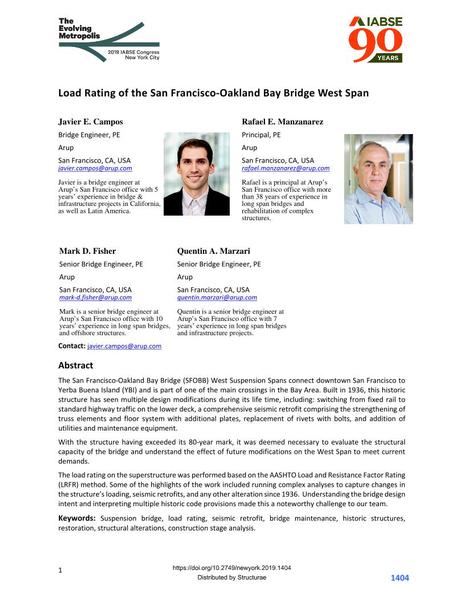Load Rating of the San Francisco-Oakland Bay Bridge West Span

|
|
|||||||||||
Bibliografische Angaben
| Autor(en): |
Javier E. Campos
(Arup)
Rafael E. Manzanarez (Arup) |
||||
|---|---|---|---|---|---|
| Medium: | Tagungsbeitrag | ||||
| Sprache(n): | Englisch | ||||
| Tagung: | IABSE Congress: The Evolving Metropolis, New York, NY, USA, 4-6 September 2019 | ||||
| Veröffentlicht in: | The Evolving Metropolis | ||||
|
|||||
| Seite(n): | 1404-1410 | ||||
| Anzahl der Seiten (im PDF): | 7 | ||||
| DOI: | 10.2749/newyork.2019.1404 | ||||
| Abstrakt: |
The San Francisco-Oakland Bay Bridge (SFOBB) West Suspension Spans connect downtown San Francisco to Yerba Buena Island (YBI) and is part of one of the main crossings in the Bay Area. Built in 1936, this historic structure has seen multiple design modifications during its life time, including: switching from fixed rail to standard highway traffic on the lower deck, a comprehensive seismic retrofit comprising the strengthening of truss elements and floor system with additional plates, replacement of rivets with bolts, and addition of utilities and maintenance equipment. With the structure having exceeded its 80-year mark, it was deemed necessary to evaluate the structural capacity of the bridge and understand the effect of future modifications on the West Span to meet current demands. The load rating on the superstructure was performed based on the AASHTO Load and Resistance Factor Rating (LRFR) method. Some of the highlights of the work included running complex analyses to capture changes in the structure’s loading, seismic retrofits, and any other alteration since 1936. Understanding the bridge design intent and interpreting multiple historic code provisions made this a noteworthy challenge to our team. |
||||
| Stichwörter: |
Hängebrücke Restaurierung Erdbebennachbemessung historische Bauten
|
||||
